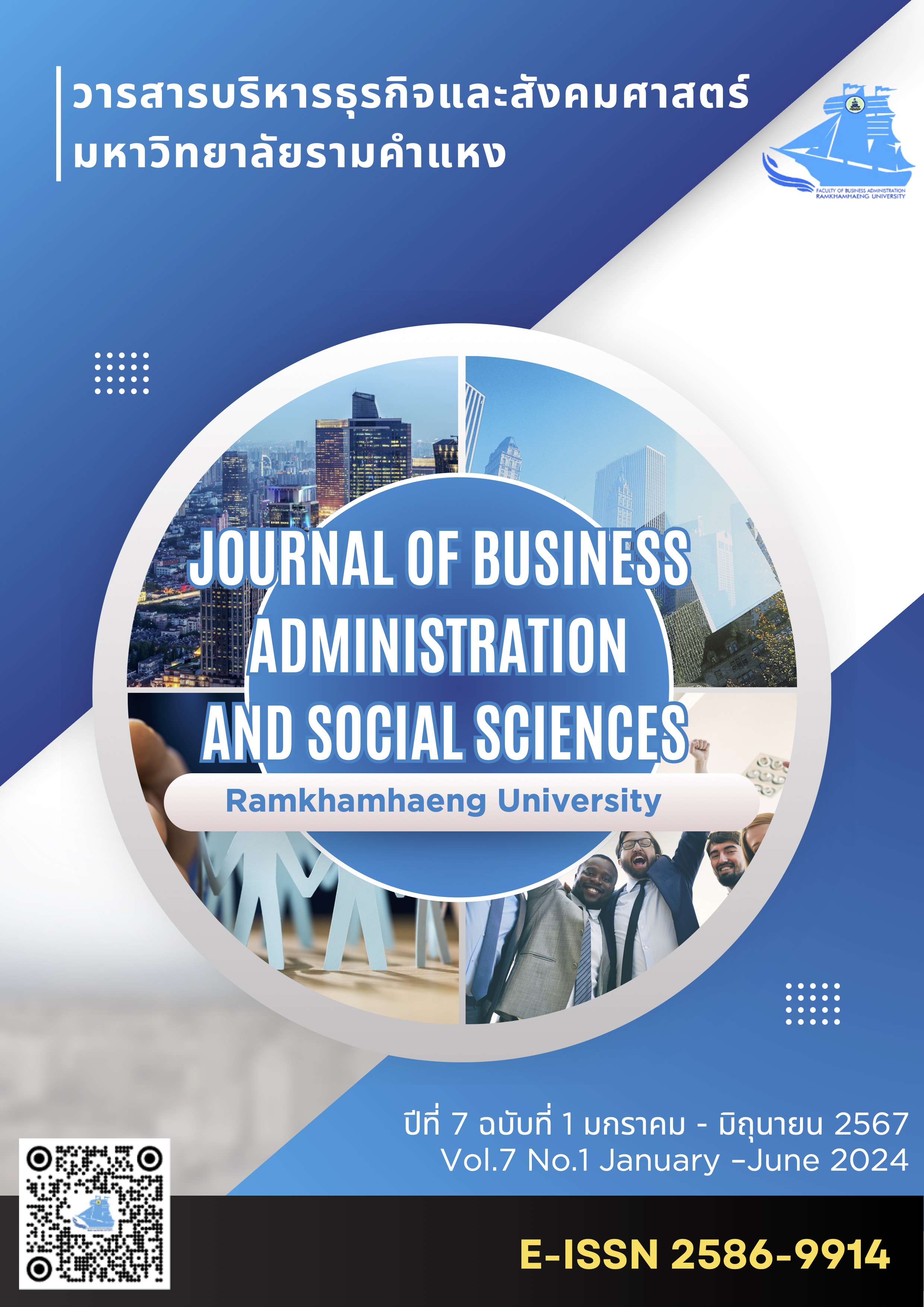Information Technology Acceptance Factors Affecting Performance Efficiency in the Electronic Tax Invoice and Receipt Systems of the Revenue Department
Main Article Content
Abstract
In this research investigation, the researcher examines the impact of the information technology acceptance factors on the performance efficiency of the electronic tax invoice systems used by the accountants in the Bangkok Metropolitan Region. A questionnaire was the research instrument to collect data. The sample population consisted of 400 accountants who used the electronic tax invoice systems in the Bangkok Metropolitan Region. Data were analyzed using t test and F test (one-way ANOVA). The hypothesis test was conducted using the technique of multiple regression analysis with stepwise regression analysis.
Findings showed that information technology acceptance exhibited a positive influence on the performance efficiency of the electronic tax invoice and receipt systems of the Revenue Department in the following order. At the highest level was the perceived ease of use (ꞵ = 0.546). Next in descending order were trust (ꞵ = 0.177) and risk perception (ꞵ = 0.081). They were explanatory of the performance efficiency of the electronic tax invoice systems with the predictive value at 47.50 percent (R Square = 0.475). The research findings will benefit the Revenue Department in raising awareness for information technology acceptance. Public relations can be conducted to show the efficiency of the use of electronic tax invoice systems in order to increase the number of system users. Additionally, the findings can be guidelines for universities to develop programs to produce graduates with the potential to use technology in their performances.
Article Details

This work is licensed under a Creative Commons Attribution-NonCommercial-NoDerivatives 4.0 International License.
เนื้อหาและข้อมูลในบทความที่ลงตีพิมพ์ในวารสารบริหารธุรกิจและสังคมศาสตร์ มหาวิทยาลัยรามคำแหง ถือเป็นข้อคิดเห็นและความรับผิดชอบของผู้เขียนบทความโดยตรง ซึ่งกองบรรณาธิการไม่จำเป็นต้องเห็นด้วย หรือร่วมรับผิดชอบใดๆ
บทความ ข้อมูล เนื้อหา รูปภาพ ฯลฯ ที่ได้รับการตีพิมพ์ในวารสารบริหารธุรกิจและสังคมศาสตร์ มหาวิทยาลัยรามคำแหง ถือเป็นลิขสิทธิ์ของวารสารบริหารธุรกิจและสังคมศาสตร์ มหาวิทยาลัยรามคำแหง หากบุคคลหรือหน่วยงานใดต้องการนำบทความทั้งหมดหรือส่วนหนึ่งส่วนใดไปเผยแพร่ต่อ หรือเพื่อกระทำการใดๆ จะต้องได้รับอนุญาตเป็นลายลักษณ์อักษรจากวารสารบริหารธุรกิจและสังคมศาสตร์ มหาวิทยาลัยรามคำแหง ก่อนเท่านั้น
References
กรมพัฒนาธุรกิจการค้า. (2562). ผู้ทำบัญชี. สืบค้นจาก https://www2.dbd. go.th/common-article/3
กรมพัฒนาธุรกิจการค้า. (2562). ดีบีดีดาต้าแวร์เฮาส์. สืบค้นจาก https://datawarehouse.dbd.go.th/index
กฤติน หนุเจริญกุล และปริณภา จิตราภัณฑ์. (2566). ปัจจัยที่ส่งผลต่อความสำเร็จของระบบบริการจัดทำ และนำส่งข้อมูลใบกำกับภาษีอิเล็กทรอนิกส์ และใบรับอิเล็กทรอนิกส์ของกรมสรรพากร. วารสารสังคมศาสตร์ปัญญาพัฒน์, 5(2), 207-222.
ฐิตารีย์ ศิริมงคล. (2563). แบบจำลองแนวคิด และข้อเสนแนะเบื้องต้น: ปัจจัยที่ส่งผลต่อความตั้งใจใช้ตลาดกลางพาณิชย์อิเล็กทรอนิกส์: การผสมผสานระหว่างกรอบแนวคิดTOE-TAM. วารสารวิชาการและวิจัยมหาวิทยาลัยภาคตะวันออกเฉียงเหนือ, 11(1), 290-303.
พระศุภกร มหาวีโร และบุญฑวรรณ วิงวอน. (2566). อิทธิพลของการรับรู้คุณภาพบริการทางอิเล็กทรอนิกส์ ความไว้วางใจทางอิเล็กทรอนิกส์และการยอมรับเทคโนโลยีที่มีผลต่อการตัดสินใจในการบริจาคเงินให้วัดของประชาชนผ่านระบบบริจาคอิเล็กทรอนิกส์ อำเภอเมืองลำปาง จังหวัดลำปาง. วารสารวิทยาการจัดการมหาวิทยาลัยราชภัฎพิบูลสงคราม, 5(1), 114-128.
วินัย ปณิธานรักษ์ชัย และประเวศ เพ็ญวุฒิกุล. (2563). ปัจจัยที่ส่งผลต่อประสิทธิภาพการปฏิบัติงานในระบบใบกำกับภาษีอิเล็กทรอนิกส์ทางอิเมลล์ของผู้ทำบัญชีในเขตกรุงเทพมหานครและปริมณฑล. วารสารวิชาการ มหาวิทยาลัยการจัดการและเทคโนโลยีอีสเทิร์น, 17(1), 513-519.
ศรุตานนท์ ชอบประดิษฐ์. (2563). วิกฤตโควิด 19 ส่งผลกระทบต่อการเปลี่ยนแปลงทางสังคมอย่างไร. วารสารชัยภูมิปริทรรศน์, 3(2), 9-12.
ศักดิ์นรินทร์ อินภิรมย์, สมบัติ ธํารงสินถาวร, ศรัญยา แสงลิ้มสุวรรณ และสานนท์ อนันทานนท์. (2564). การศึกษาการยอมรับการใช้งานระบบใบกํากับภาษีอิเล็กทรอนิกส์ และใบรับอิเล็กทรอนิกส์. วารสารวิชาการ มทร.สุวรรณภูมิ, 6(2), 212–227.
สุกฤตา บุรินทร์วัฒนา, จิตติชัย ห่อทอง, สวียา ปรารถนาดี, จันทิมา งานโคกกรวด, นิวัต กุลศุภโชติ และเบญจมาศ อภิสิทธิ์ภิญโญ. (2564). อิทธิพลของการยอมรับเทคโนโลยีต่อความตั้งใจใช้งานระบบภาษีและเอกสารธุรกรรมอิเล็กทรอนิกส์ของผู้ทำบัญชีในประเทศไทย. ราชภัฎเพชรบูรณ์สาร, 23(2),87-96.
สุรพงษ์ คงสัตย์ และ ธีรชาติ ธรรมวงค์. (2551). การหาค่าความเที่ยงตรงของแบบสอบถาม (IOC). สืบค้นเมื่อวันที่ 3 กรกฎาคม 2565 จาก https://www.mcu.ac.th/article/detail/14329.
อนุกูล เยี่ยงพฤกษาวัลย์. (2550). พัฒนาบุคคลเพื่อประสิทธิภาพของงาน. กรุงเทพฯ: สยามมิตร.
Al-Mawali, H., Al Natour, A. R., Zaidan, H., Shishan, F., & Rumman, G. A. (2022). Examining the Factors Influencing E-Tax Declaration Usage among Academics’ Taxpayers in Jordan. Informatics, 9(4),1-15
Bramantyo, S. (2020). A. Determinants of e-tax system acceptance by users. Russian Journal of Agricultural and Socio-Economic Sciences, 101(5), 169-174.
Chuc, N. D., & Anh, D. T. (2023). Digital Transformation in Vietnam. Journal of Southeast Asian Economies, 40(1), 127-144.
Davis, F. (1989). Perceived Usefulness, Perceived Ease of Use, and User Acceptance of Information Technology. MIS Quarterly, 13(3), 319-339.
Davis, F. (1985). A technology acceptance model for empirically testing new end-user informtation systems: theory an results. Unpublished Doctoral dissertation. MIT Sloan School of Management.
Felani, M. R., & Fidiana, F. (2022). Kepatuhan Pelaporan E-Faktur 3.0 Berdasarkan Persepsi Efikasi Diri, Kebermanfaatan, dan Kemudahan. Jurnal Kajian Akuntansi, 6(1), 90-105.
Hair, J.F., Black, W.C., Babin, B.J.,Anderson, R.E., & Tatham, R.L. (2010). Multivariate data analysis (7th ed.). New York: Pearson.
Harb, J., Morton, E., & Narayanan, V. (202). Acceptance of myTax in Australia. Australian Tax Forum, 38(1), 111-149.
Kanaan, A., AL-Hawamleh, A., Abulfaraj, A., Al-Kaseasbeh, H., & Alorfi, A. (2023). The effect of quality, security and privacy factors on trust and intention to use e-government services. International Journal of Data and Network Science, 7(1), 185-198.
Latifa, F., Ritchi, H., & Tanzil, N. D. (2023). The journey and performance of e-tax invoicing in indonesia: a systematic literatur review. Jurnal Riset Akuntansi dan Bisnis Airlangga (JRABA), 8(1), 1395-1417.
Likert, R. (1976). New Patterns of Management. New York:McGraw–Hill.
Mawar, P., & Juita, M. V. (2022). Perception analysis of self-efficiency, usefulness and easy about e-invoice version 3.1 towards compliance with reporting of vat E-SPT period in Surabaya. Jurnal Mantik, 6(1), 915-922.
Miurin J. (2019). The B2B electronic invoicing, between the European system transition and anti-fraud mechanisms of value added tax and a momentum for accounting operational performance improvements [Electronic Version]. Università Ca' Foscari Venezia: 189-191.
Mosteanu & Faccia. (2019). Accounting and blockchain technology: from double-entry to triple-entry [Electronic Version]. In ICCBDC 2019: Proceedings of the 2019 3rd International Conference on Cloud and Big Data Computing, 31-37.
Pallant, J. (2016). SPSS survival manual: A step-by-step guide to data analysis using SPSS version 15. Nova lorque: McGraw Hill.
Peterson, E., & Plowman, E. G. (1953). Business organization and management–home wood. Illinoise: Richard D. Irwin.
Rovinelli, R. J. and Hambleton, R. K. (1977). On the Use Content Specialist in the Assessment of Criterin Reference Test Item Validity. Dutch Journal of Educational Research, 2, 49-60.
Tenardi, R., & Putranti, T. M. (2020). Administration Of E-Invoicing Value Added Tax (Comparative Study between Indonesia and Australia). Jurnal Manajemen Pelayanan Publik, 4(1), 1-24.
Valenti P. (2011). E-Government and Competitiveness in Latin America: The Case of the Electronic Invoice. Global Strategy and Practice of E-Governance: 380-396.
Yamane. (1967). Taro Statistic: An Introductory Analysis. New York: Harper & row.


